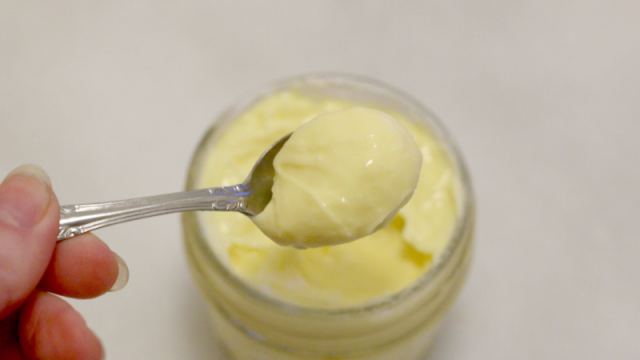I really like mayonnaise. As someone who has eaten more than her fair share of church suppers, I think it’s a condiment that goes beyond the sandwich. Making my own was a real game changer, but duck fat mayo refuses to play the game at all.
Photo by Claire Lower
We’ll get to the quackonnaise in a moment, but let’s start with a basic mayo recipe for the uninitiated. Homemade mayonnaise is richer, creamier and more flavourful than store-bought, and it also isn’t that difficult to make. In terms of emulsification, you really can’t go wrong with the Food Lab’s immersion blender method, which works with literally any mayo recipe I’ve thrown at it. For a basic mayo, I use the following:
- 1 egg yolk
- 1 tablespoon of fresh lemon juice
- 1 teaspoon white wine vinegar
- 1/2 teaspoon dijon mustard
- 1/2 teaspoon salt
- 1/2 teaspoon sugar
- 3/4 cup safflower oil
Place everything but the oil in the cup that came with your immersion blender and gently pour the oil on top. (A different cup would work too. Kenji advises using a receptacle just barely wider than the head of the blender, though I’ve made mayo in wider containers and found it worked just fine.) Place the blender head down at the bottom, turn it on high, and let the blades pull the oil down into the other ingredients. Once you see ribbons of mayo start to form, slowly move the head up and down, tilting it as needed to get everything emulsified. Transfer to a sealable container (or directly to a sandwich) and store in the fridge for up to two weeks.
The last time I made this mayo, I had to shuffle the contents of my fridge around to make room for it (worth it). As I was doing so, I spied my BFF duck fat and was struck with the need to transform it into a creamy, dreamy spread for all my sandwich needs. I tried a direct one-for-one swap of safflower oil for the lard and, though it tasted quite good, it was too liquidy for spreading. I added some safflower oil and another yolk, and it thickened slightly, but I still had more of a sauce (perfect for a Benedict or some asparagus) than a mayo. After a bit of tinkering around, I landed on the following recipe:
- 2 egg yolks
- 1 tablespoon of fresh lemon juice
- 1 teaspoon white wine vinegar
- 1/2 teaspoon dijon mustard
- 1/2 teaspoon salt
- 1/2 teaspoon sugar
- 1/2 cup safflower oil
- 1/4 cup duck fat, melted
Melt the duck fat in the microwave so it’s just liquified, and pour the safflower oil in the same measuring cup to cool it down a bit. (You don’t want to cook your yolks.) Add everything but the oil mixture in the cup that came with your immersion blender and gently pour the oil on top. Place the blender head down at the bottom, turn it on high, and let the blades pull the oil down into the other ingredients. Once you see ribbons of mayo start to form, slowly move the head up and down, tilting it as needed to get everything emulsified.
Both types of mayonnaise are fantastic examples of the genre, and are creamy, slightly tangy and oh-so-spreadable. The duck fat mayo, however, has a smoky, slightly meaty, umami-rich flavour that has me dreaming of simple tomato sandwiches and piles of potato salad. I wouldn’t hate it as a base for a creamy salad dressing either. (I don’t think I’d use it in a cake, though; the plain stuff works best there.)

Comments
One response to “Why Duck Fat Mayo Is The Mayo You Should Be Making ”
i have used duck fat in a cake – worked very well, with no taste of its origins